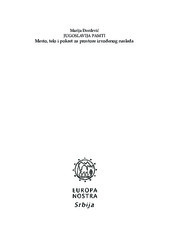Приказ основних података о документу
Jugoslavija pamti: mesto, telo i pokret za prostore izvođenog nasleđa
| dc.creator | Đorđević, Marija | |
| dc.date.accessioned | 2023-01-09T12:04:29Z | |
| dc.date.available | 2023-01-09T12:04:29Z | |
| dc.date.issued | 2021 | |
| dc.identifier.isbn | 978-86-917157-9-3 | |
| dc.identifier.uri | http://reff.f.bg.ac.rs/handle/123456789/4125 | |
| dc.description.abstract | Commemorations hold an important position in processes of formulating and maintaining memory and identity of a commu- nity regardless of its size and the point of gathering. Their role in keeping the official narratives of a community has historically been their most recognized and investigated aspect. However, the often overlooked task of a commemoration is to create space in which the values and norms of the community will temporarily take-on flesh. With an aim of investigating them as space-making actions, this dissertation brings the focus to a different aspect of commemora- tive performances – to their three-way corporal conditioning, and therefore to the didactic potential they are endowed with. The latter is done by investigating the basic manner in which commemorati- ons as performances are structured. Commemorations are approa- ched as site-specific performances, and their scripts are analyzed by co-relating their three main segments – the site, body and action. The latter is achieved through analysis of three specific case studies of public commemorations fashioned during the existence of SFRY. Through the analysis of their scripts and the actual performances taking place, the employed official bodily didactics is deconstructed, and the final result – the space made by an educated body – is se- arched for and analyzed, in order to disclose the nuanced changes in the meanings and values put forward by its creators over time, through employment of the body in performance in the same way. The longevity and contemporary relevance of three analyzed public performances – “Great School Lesson” (Kragujevac, Serbia), commemoration of the Battle of Sutjeska (Tjentište, BiH) and cele- bration of “13th of July” (Montenegro) – positions them as items to be inherited, and therefore brings the discussion to the realms of heritage theory and practice. However, when viewed as space-ma- king action, the commemorations cannot be easily simplified to the level of intangible and tangible binary put forward by UNESCO. As the one potential category of in-between, this dissertation provides a further conceptualization of performing heritage. Performing he- ritage is determined as heritage type that deals with these practices and in them used sites as unquestionably dynamic traits of human action. With a goal of honoring their inherited duality (being simul- taneously intangible and tangible), it is proposed to look at comme- morations from the point of the one of its main end-results – the space; therefore, determining performing heritage as heritage of the space-making process | sr |
| dc.language.iso | sr | sr |
| dc.publisher | Evropa Nostra Srbija | sr |
| dc.rights | openAccess | sr |
| dc.rights.uri | https://creativecommons.org/licenses/by/4.0/ | |
| dc.subject | NOB | sr |
| dc.subject | komemoracija | sr |
| dc.subject | izvođeno nasleđe | sr |
| dc.subject | mesto | sr |
| dc.subject | telo | sr |
| dc.subject | pokret | sr |
| dc.subject | prostor | sr |
| dc.title | Jugoslavija pamti: mesto, telo i pokret za prostore izvođenog nasleđa | sr |
| dc.type | book | sr |
| dc.rights.license | BY | sr |
| dc.identifier.fulltext | http://reff.f.bg.ac.rs/bitstream/id/9952/bitstream_9952.pdf | |
| dc.identifier.rcub | https://hdl.handle.net/21.15107/rcub_reff_4125 | |
| dc.type.version | publishedVersion | sr |

